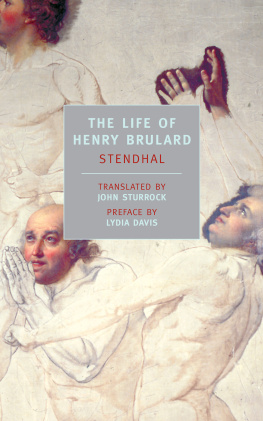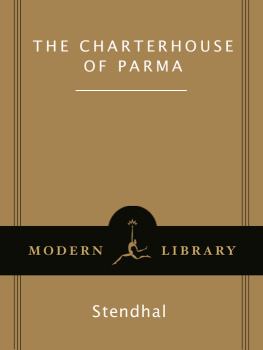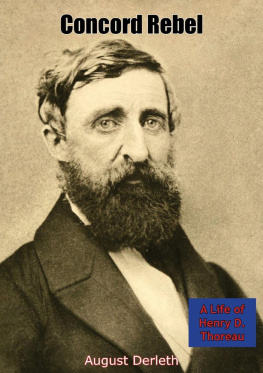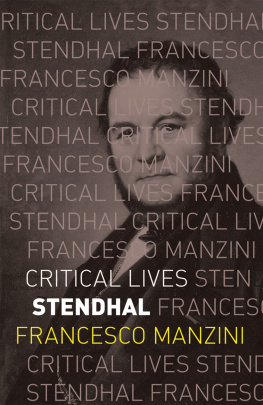STENDHAL (17831842), the pen name of Henri Marie Beyle, was born into a prosperous family in Grenoble. At sixteen he set out for Paris, intending to pursue a career as an engineer, but instead enlisted in Napoleons Army. Stendhal took part in campaigns in Italy, Germany, Russia, and Austria, and then, after Napoleons fall from power, settled in Milan, where he wrote books on art and music. Expelled from Italy for political reasons in 1821, he returned to Paris; following the 1830 revolution, he secured the position, which he was to hold for the rest of his life, of French Consul to Civitavecchia. Stendhals great novels The Red and the Black (1830) and The Charterhouse of Parma (1839) were largely ignored during his lifetime, and many of his works remained unfinished and were published only posthumously. Among his most important books are On Love, Lucien Leuwen, The Memoirs of an Egotist, and The Life of Henry Brulard.
LYDIA DAVIS is the author of several works of fiction, including Break It Down, The End of the Story, and, most recently, Samuel Johnson Is Indignant: Stories.
THE LIFE OF HENRY BRULARD
STENDHAL
Translated and with an Introduction by
JOHN STURROCK
Preface by
LYDIA DAVIS
NEW YORK REVIEW BOOKS

New York
This is a New York Review Book
Published by The New York Review of Books
435 Hudson Street, New York, NY 10014
www.nyrb.com
Translation and introduction copyright 1995 by John Sturrock
Preface copyright 2002 by Lydia Davis
All rights reserved.
Front cover illustration: Jacques Louis David, The Oath of the Tennis Court, June 20, 1789. Life-size preparatory drawing. Chateaux de Versailles et de Trianon. Runion des Muses Nationaux/Art Resource
Cover design: Katy Homans
The Library of Congress has cataloged the print edition as follows:
Stendhal, 17831842.
[Vie de Henry Brulard. English]
The life of Henry Brulard / Stendhal ; translated and with an introduction by John Sturrock ; preface by Lydia Davis.
p. cm.
ISBN 0-940322-89-7 (alk. paper)
1. Stendhal, 17831842. 2. Novelists, French19th centuryBiography. I. Sturrock, John. II. Title.
PQ2436.A2 V43 2002
843'.7dc21 2001006230
ISBN 978-1-681371-22-1
v1.0
For a complete list of titles visit www.nyrb.com or write to: Catalog Requests, NYRB, 435 Hudson Street, New York, NY 10014
CONTENTS
A NOTE ON THE TRANSLATION
The French text used here is that of the definitive 1982 Pliade edition of Henry Brulard, edited by Professor V. Del Litto, of whose magnificently full notes in that edition I have also made use. Those words and phrases which appear in the original in Stendhals English appear in this translation in small capitals, THUS . Stendhals own footnotes or additions to the main text are marked with symbols; my own explanatory footnotes are marked with arabic numerals, or occasionally inserted within Stendhals notes in brackets and introduced by the word trans. The words or bits of words appearing in square brackets reproduce the editorial interpolations of the Pliade edition; I have kept some though not all of these, in order to preserve the impression of haste and nonchalance so characteristic of Stendhals prose.
I am grateful for items of help given to me in making this translation by Alison Finch, Douglas Johnson and Richard Holmes.
J. S.
TITLES
LIFE OF H[ENR]Y BRUL[ARD]
written by himself.
LIFE . Nov[ember 18]35.
LIFE OF HENRY BRULARD
written by himself. Novel imitated from
The Vicar of Wakefield.
To Messrs of the Police.
This is a novel imitated from the Vicar of Wakefield.
The hero, Henry Brulard, writes his life, at the age of fifty-two, after the death of his wife, the celebrated Charlotte Corday.
Beginning of the work volume I. I, Henry Brulard wrote what follows in Rome between 1832 and 1836.
VOLUME II
LIFE OF HENRY BRULARD
written by himself, a moral novel.
To Messrs of the Police, nothing political. The hero of this novel ends by becoming a priest like Jocelyn.
LIFE OF HENRY BRULARD
written by himself, volume two.
Novel imitated from the Vicar of Wakefield above all in the purity of its sentiments.
LIFE OF H[ENR]Y BRULARD
VOLUME III .
Third volume begun 20 January 1836 at page 501, finished 10 March 1836 at Civita-Vecchia at 796. Life of Henry Brulard, written by himself. Novel of details, imitated from the Vicar of Wakefield.
To Messieurs of the Police.
Nothing political in this novel. The scheme is a hothead of every kind who grows weary and slowly sees the light and ends by devoting himself to the cult of luxurious town-houses.
These are the various title-pages for the first three volumes of his autobiography, as included by Stendhal in the Ms.
The celebrated assassin of the French Revolutionary leader, Marat; she was guillotined in 1793. The implication of this sardonic claim to kinship by Stendhal is that he is perfectly respectable politically as having been the husband of so heroic a reactionary.
The priest-hero of a long poem by Alphonse de Lamartine, published in 1836. The religiose and sentimental Lamartine was not a writer admired by Stendhal.
INTRODUCTION
In The Life of Henry Brulard one of Frances greatest novelists looks ruthlessly back at his experience of childhood and adolescence: at seventeen years which he would have us know were ones for him of solid unhappiness. Stendhals is the most unforgiving of autobiographies, long on resentment against his family, his hometown and his fellow-countrymen, and exceedingly short on charity; but it is also one of the most readable: throwaway in manner, full of droll asides and caustic judgments, and brilliantly lucid when reaching into the psychological depths of both its author and those around him. Henry Brulard has no truck with the gravity or good manners of so much nineteenth-century writing; indeed, it is hard to credit that it is a product of the 1830s.
But then it is the work of a man who was born in one century, who did his writing in another, but who thought he might find readers capable of appreciating him only in a third, and that our own century. Even more than most autobiographies, Henry Brulard was a book offered to futurity, to be published if at all only once its much misunderstood author was safely dead and out of reach of those he had wanted to malign. It may stand as a posthumous act of score-settling. Stendhals literary executor was too taken aback by it to let it be published, and it appeared for the first time only in 1890, forty-eight years after its authors sudden death, of apoplexy, in a Paris street. Even then a nervous editor thought that the works graceless style, if not its apparent nihilism, would be too much for sensitive readers, and groomed the manuscript accordingly.
Stendhals idea that the future might take to him as a writer, even if the present did not, was prophetic: the future has taken to him. The iconoclastic philosophy and abrupt literary manner that were found either puzzling or rebarbative by his contemporaries will seem certainly familiar and perhaps congenial by someone reading Henry Brulard today. In this autobiography Stendhal makes the case for himself as a defiant anachronism, a man forced to live in, without in any sense belonging to, the 1830s. For someone of his passionate tastes the times were all wrong, they were venal, complacent, hypocritical: in a word,












